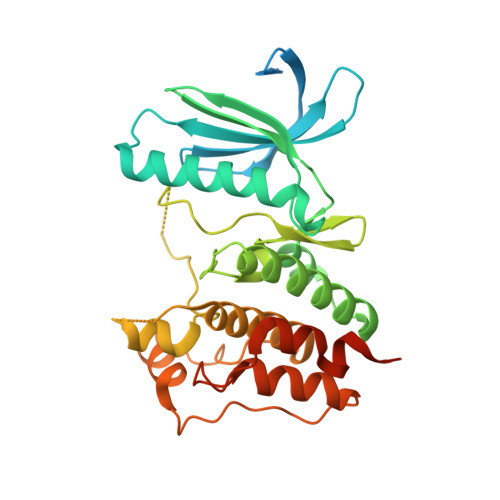Biophysical and X-ray crystallographic analysis of Mps1 kinase inhibitor complexes.
Chu, M.L., Lang, Z., Chavas, L.M., Neres, J., Fedorova, O.S., Tabernero, L., Cherry, M., Williams, D.H., Douglas, K.T., Eyers, P.A.(2010) Biochemistry 49: 1689-1701
- PubMed: 20099905
- DOI: https://doi.org/10.1021/bi901970c
- Primary Citation of Related Structures:
3HMN, 3HMO, 3HMP - PubMed Abstract:
The dual-specificity protein kinase monopolar spindle 1 (Mps1) is a central component of the mitotic spindle assembly checkpoint (SAC), a sensing mechanism that prevents anaphase until all chromosomes are bioriented on the metaphase plate. Partial depletion of Mps1 protein levels sensitizes transformed, but not untransformed, human cells to therapeutic doses of the anticancer agent Taxol, making it an attractive novel therapeutic cancer target. We have previously determined the X-ray structure of the catalytic domain of human Mps1 in complex with the anthrapyrazolone kinase inhibitor SP600125. In order to validate distinct inhibitors that target this enzyme and improve our understanding of nucleotide binding site architecture, we now report a biophysical and structural evaluation of the Mps1 catalytic domain in the presence of ATP and the aspecific model kinase inhibitor staurosporine. Collective in silico, enzymatic, and fluorescent screens also identified several new lead quinazoline Mps1 inhibitors, including a low-affinity compound termed Compound 4 (Cpd 4), whose interaction with the Mps1 kinase domain was further characterized by X-ray crystallography. A novel biophysical analysis demonstrated that the intrinsic fluorescence of SP600125 changed markedly upon Mps1 binding, allowing spectrophotometric displacement analysis and determination of dissociation constants for ATP-competitive Mps1 inhibitors. By illuminating the structure of the Mps1 ATP-binding site our results provide novel biophysical insights into Mps1-ligand interactions that will be useful for the development of specific Mps1 inhibitors, including those employing a therapeutically validated quinazoline template.
Organizational Affiliation:
Wolfson Centre for Structure-Based Rational Design of Molecular Diagnostics, School of Pharmacy and Pharmaceutical Sciences, University of Manchester, Manchester M13 9PL, UK.



















